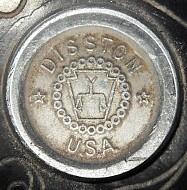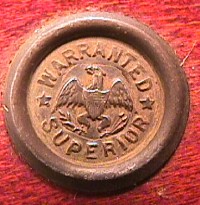
|
The medallions on Disston handsaws changed more over time than any other feature on the saw. By using the medallion, you can estimate the age of your saw. |
The Medallions and Timeline of Saw ManufactureThe medallions on Disston saws give the most accurate indication of manufacturing dates for handsaws, panel saws, and backsaws. The first complete timeline of Disston handsaws was written by Pete Taran and published in the Winter 2001 issue of the Fine Tool Journal. His article assigned manufacturing dates to Disston saws, based on the medallions, creating what is called a type study. Since the publication of Taran's ground-breaking research, the number of known medallions has increased significantly, and they have been featured on the Disstonian Institute website. |
|
1840's |
|||
The purpose of this section is to show that the earliest Disston saws had no medallions and to offer evidence of which medallions were first used when they appeared in the mid-1840's. Backsaws often lived pampered lives inside toolboxes, taken out only to be used at a bench and put away. Handsaws were not so lucky, usually rode hard and put away wet, mostly used outdoors. There are not so many handsaws left to give evidence of how the design of the saws evolved and how they were labeled. Collector and researcher Phil Baker has a remarkable collection of early backsaws that demonstrate the evolution of Disston's saws, a few of which are shown here. Henry Disston's backsaw design changed dramatically over a span of five to eight years during the 1840's. This handle from a 16" saw has typically English full cheeks and a hook at the top, front of the handle. Baker estimates the date of this saw to 1842. |

|
||
Here is a similarly-sized saw from approximately 1846 featuring the hook and an "eagle in flight" medallion, which is described in the next section. |
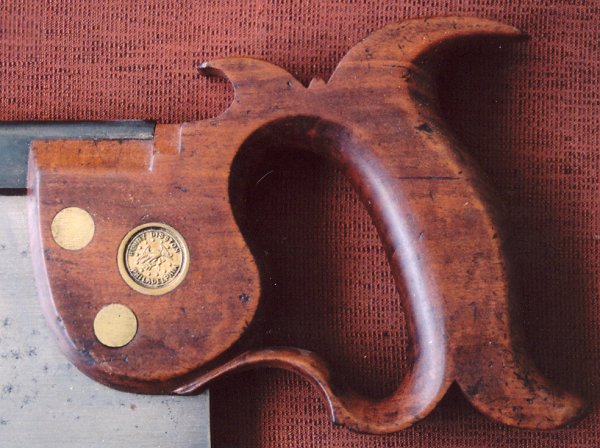
|
||
This shorter backsaw has the hook, no medallion, and a finely detailed handle with lambs's tongue. Baker estimates its date to 1843-44. |

|
||
This similarly-designed handle has the medallion and may have been made 1845-46. The handle features a double nib, both top and bottom, which coincides with a brass back on these early backsaws. |

|
||
The hook is still featured on this 1846-47 saw. It has a different medallion with an eagle, but it reads "Warranted Superior". |
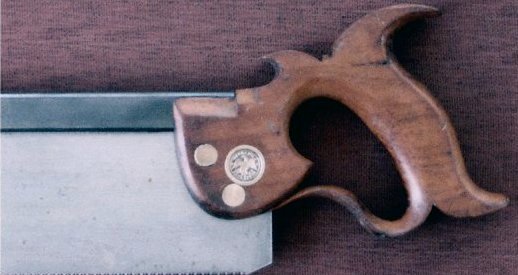
|
||
Baker estimates the date of this saw to 1847-48. It has the "optimistic" eagle medallion and the handle design is not as fussy, so was sturdier and less work to manufacture. The hook never reappeared on Disston saw handles. The other, more significant, design change taking place during this period was the deepening of the angle of the handle from 25 degrees to 35 degrees. What follows is a progression of all medallions produced by Disston from the 1840's until 1955. |
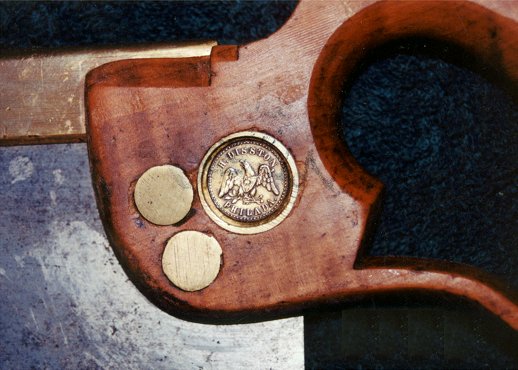
|
||
1840's-1850's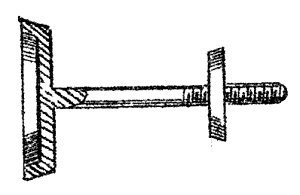
|
|||
|
(found on full-sized handsaws) |
(found on backsaws and panel saws) |
||
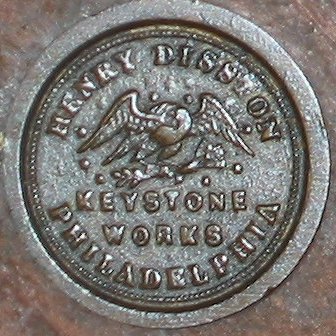
|
The earliest medallions appear on saws with features that also appear on saws with no medallions. The beak on the top front of a backsaw handle appears only on saws with either no medallion or the medallion on the right. This evidence is the basis for putting this medallion first on the list, a departure from other type studies. The larger medallion on the left includes the phrase Keystone Works, which appeared in the first-known Disston sales literature, published in 1850. The first two medallions in each column, left and right, are identical. Two examples of each are shown for clarity. Collector and researcher Phil Baker has coined the term "eagle in flight" to describe this early medallion. The design makes it hard to see the head of the eagle.
Disston started out making only several hundred saws annually in the first years of production, increasing to perhaps 10 or 14 thousand saws per year in 1850. That figure is interpolation based on the statement in advertising that "dozens" of saws were made each day in the factory that year. Disston's first employee, David Bickley, reported in an 1890 interview that Disston made no saws at all for the first two years of work in three locations, Arch Street, Third St., and Bread St. They made mason's trowels and cleavers. Disston is listed as a saw and tool maker at 21 Bread St. in the 1842 McElroy's Directory of Philadelphia. Directories from 1844 and 1846 list the address as 99 Mulberry St., which was at the corner of Third Street. Mulberry Street was the older name for Arch Street. On the same block stands the Betsy Ross house, between Bread Street and Third.
By 1847 Disston moved about a mile north to a rented 400 sq. foot space in the factory of
William Mills on Maiden and Front Streets, where he worked with two
apprentices until a boiler explosion in 1849 burned the factory down.
Maiden Street was later renamed Laurel. The left medallion appears on a No. 8 handsaw, the right, from a late 1840's or early 1850's backsaw. Both read "H. Disston. Philada". Note the eagle's head is pointed upward. The earliest medallions had optimistic-appearing eagles. A distinct possibility is that these medallions were not made in a progression like those after the Civil War. The variations seen in the 1840's and 50's may have been produced at the same time. All of the medallions made before 1868 are cast in sand. The later ones were made by the Washbourne patented process: stamped from sheet brass, impressed with a die to make the keystone and lettering, and the bolt was soldered into the back of the disc. The process used to form the early medallions was to make a line of impressions of the medallion in fine casting sand, connecting them with a channel. Molten brass was poured into the mold, and the resulting medallions were then cut apart. |
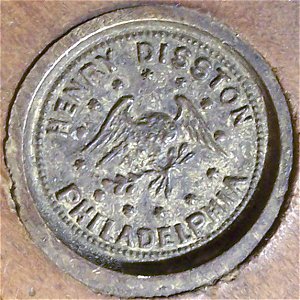
|
|
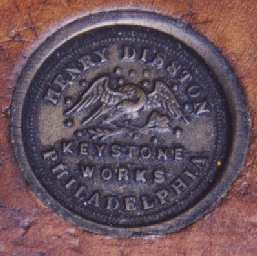
|
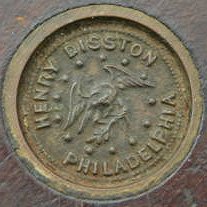
|
||
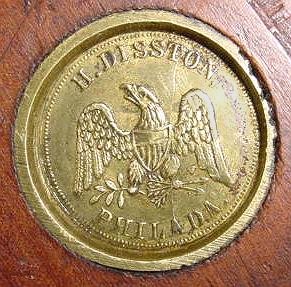
|

|
||
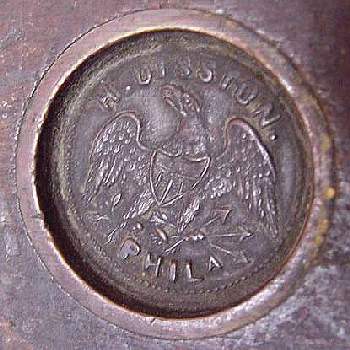
|
There would have been an additional part put on top of the sand mold to form the bolt shaft, which was later threaded. There is no documentation to show how this was accomplished. This method must have had in a high rejection rate. Any voids, particularly in the shaft, would have resulted in scrap. The result was a brittle medallion of low density that makes a "thunk" noise when dropped. Struck medallions, somewhat like coins, make a ringing sound when dropped.
Late 1840's or early 50's medallions left and right with "H. Disston. Phila" in the stamp. Note the small size of the letter "A". This feature comes and goes for four decades, 1850's-1880's. This Federal-style was used for perhaps a decade before a stylized, Aztec type of eagle was introduced. |

|
|
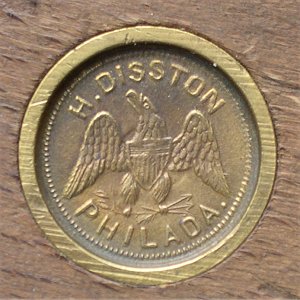
|
These eagle medallions have a bird similar to those above it, but the abbreviation for Philadelphia has been changed. |
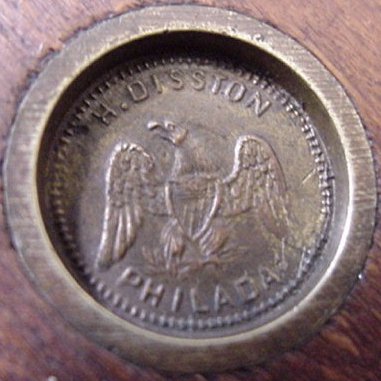
|
|
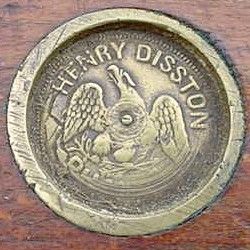
|
More medallions from the late-1840's early 1850's era. Note the full spelling of "Henry." Thanks to Mr. Strasil for the contribution. | 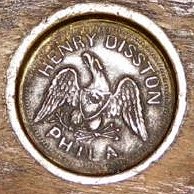
|
|

|
Two medallions, one from a full sized saw, the other from a backsaw. The eagle is similar to the designs above, except it is the mirror image. The lettering has serifs, six-pointed stars flank the eagle, and the city is abbreviated "Philada". |

|
|
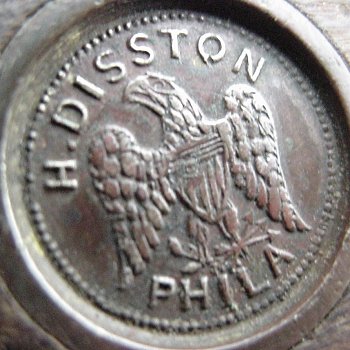
|
I wish I could say exactly where this medallion fits in the order, but there is no evidence indicate that. It was found on a No. 7 handsaw from the late 1840's or early 1850's. Notice the style of the eagle has changed from the Federal-style eagle found, for example, on US coins and is more stylized. This style change appears in the later versions of the eagle medallions. | ||

|
This medallion dates to the middle and late 1850's. It clearly is different in style from those preceding it, and is much like those made in the 1860's, with only minor differences. This and the medallion from the 1860-1865 period below are the most common eagle medallions. |

|
|
1860-1865 |
|||
|
(found on full-sized handsaws) |
(found on backsaws and panel saws) |
||
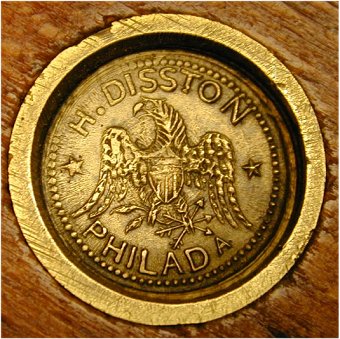
|
These are examples of the 1860's medallion used until the "one-son" medallion started to appear in 1865. The only significant difference between this and the medallion directly above it is the appearance of stars flanking the eagle. The established date for this medallion begins in 1860. It is necessary to point out that the date is not precise, as in, "it was put on saws starting on the date 1/1/60." There is no evidence to put most of these production dates to anything closer than a reasonable estimation. For example, this one may have appeared initially on any date between, say, 1858 and 1862; there is no evidence to say precisely. Some medallions from the 1870's can be said to have been introduced during a specific year, while others can be categorized only by decade, such as those made before the Civil War. | 
|
|
1865-71 |
|||
|
1865-71 One-son medallion. Split sawnuts. The company changed its name to Disston and Son in 1865, when Henry Disston's eldest son Hamilton joined the business. He had apprenticed at the company in the late 1850's and early 1860's. During the Civil War he joined the Union Army against his father's wishes. Henry Disston relented and eventually encouraged other workers to volunteer. "Ham" Disston's war experience, volunteer work in the fire department, and hands-on work in the factory made him popular with the other employees. This particular medallion is rarely seen, and was produced for only a short time before the keystone medallion was introduced. Often saws from the mid to late 1860's feature a Disston and Son etch on the blade and the earlier eagle medallion with only Henry Disston's name. The materials that were in stock were used even if the names on them were not up-to-date. |
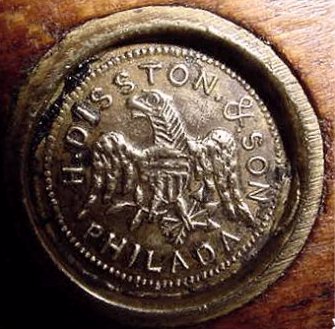
|
||
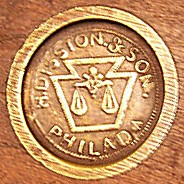
|
One son medallion, 1865-71. This is found more frequently than the previous medallion. When Albert Disston completed his apprenticeship at the factory in 1871, the company became Disston and Sons. Three younger brothers: Horace, William, and Jacob, eventually worked for the company as well.
Antique tool sellers, including both a big-name auctioneer and countless small-time dealers have made the mistake of saying the appearance of "and Son" followed by "and Sons" was a type of birth announcement. The name changes came as Henry Disston's adult sons became his business partners. |
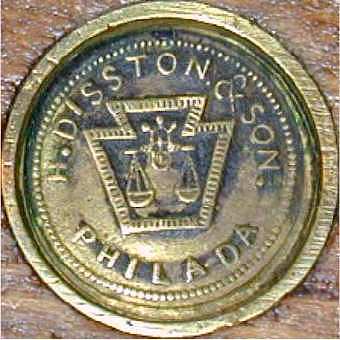
|
|
1871-75 |
|||
|
(found on full-sized handsaws) |
(found on backsaws and panel saws) |
||

|
The company changed its name to Disston and Sons in 1871.
This medallion often appears on saws with the "one son" etch, making it the first medallion to feature the word "sons." It still features the old-style split sawnuts that were used until about 1876. The perimeter is also sanded flush with the surface of the handle, as were all previous medallions. This changed with the introduction of the new-style saw nuts in the mid-1870's. |
||
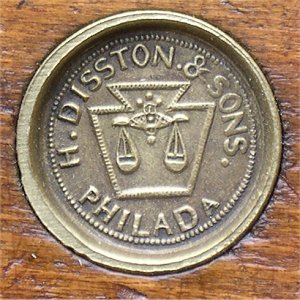
|
This medallion, the one before, and the next, are all variations on the same design and time frame, the 1871-74 period. It has a dot at the end of the word "SONS". The left medallion is from a No. 7 handsaw with the older style handle that was less ornate. On the right is a medallion from a No. 7 panel saw of the same period. |
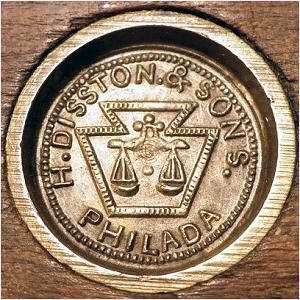
|
|
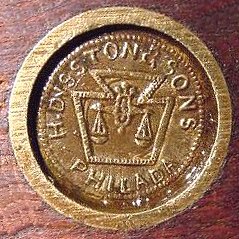
|
As you can see, there were several medallion designs in the 1871-76 era, with subtle differences in appearance. This medallion also has a larger letter "A" at the end of word "Philad'a" than on earlier saws. I have no evidence to say whether this medallion or the one immediately above is older. | 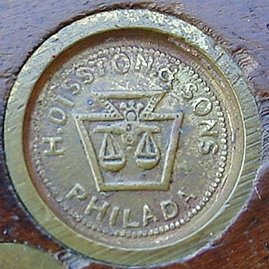
|
|
The lettering on this small medallion has serifs, unlike those before or after its production. There is no evidence to say exactly where in the sequence from 1871-75 this medallion appeared. |
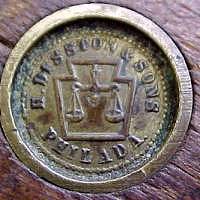
|
||
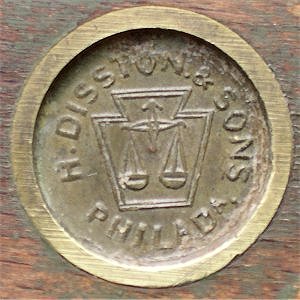
|
This medallion is mounted on a No. 7 handsaw with the later style handle with the lamb's tongue and other details. Its perimeter is flush with the handle's surface, like all that precede it, but the lettering and design of the keystone and scale are identical to the unique "Choice" saw medallion shown below. This dates the medallion close to 1874-75. The split-nut or spanner style of fastener is about to be phased out. The ring of dots around the perimeter of the medallion is gone as well. The "A" at the end of "PHILADA" appears small again, so this feature is of no help in establishing the medallion sequence. | 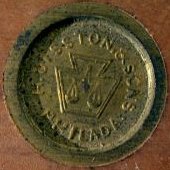
|
|

|
This medallion is on a mid-1870's "Choice" saw, which was introduced about 1875. The perimeter is serrated, which is unique. It is raised above the surface of the handle, the first time that feature is seen. The saw has five split nuts on the handle, which also is unique to this model. | ||
|
|
|||
1876-77 |
|||
|
(found on full-sized handsaws) |
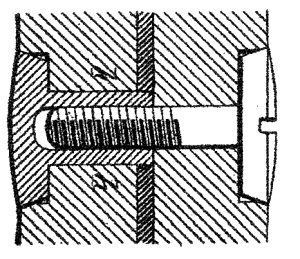 These medallions first appeared in 1876 and have a major difference from those made before them, they are attached with cap screws instead of split nuts. The design was patented by Disston on August 29, 1876. Instead of sitting completely flush with the handle like earlier medallions, there is a slight radius to the perimeter of the medallion, which rises above the wood. |
(found on backsaws and panel saws) |
|

|
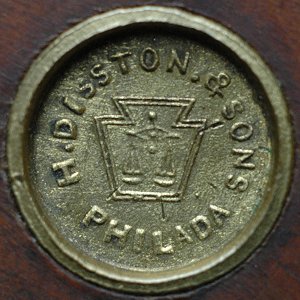
|
||
1878-88 |
|||
|
(found on full-sized handsaws) |
(found on backsaws and panel saws) |
||
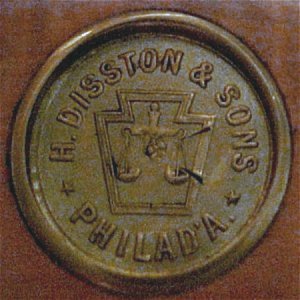
|
This medallion is actually a little older than previously shown. This example is from a No. 99 handsaw that was presented to President Rutherford B. Hayes at the factory on April 16, 1878. It was manufactured while he was touring the plant. | ||

|
This appears to be of the same design as the Hayes saw. Although it's hard to see in the image of the Hayes saw, both medallions have a comma after the word "sons". | ||

|
The images of medallions from this period show small variations in the design, particularly in the punctuation and design of the keystone and scale. The bottom example has webbing in the keystone shape. |
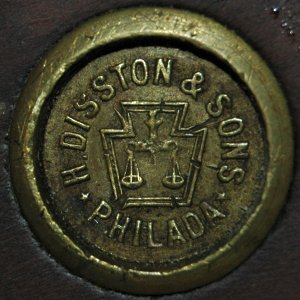
|
|
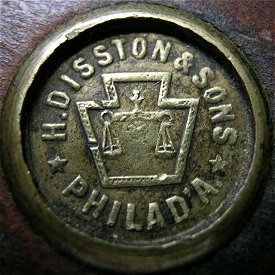
|
|||
1888-96 |
|||
|
(found on full-sized handsaws) |
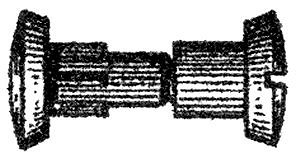 1888-early 1890's. Patent date for Glover's design of saw nuts, which are stronger than those manufactured in the 1870's and early 1880's. For an interesting anomaly in this medallion click here. |
(found on backsaws and panel saws as well as No. 16 full-sized saws) |
|
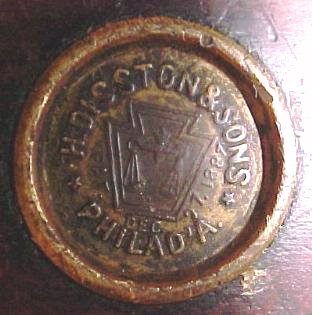
|
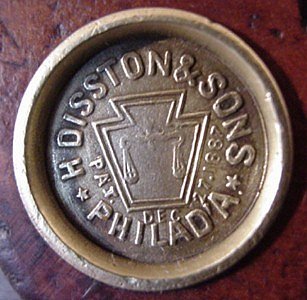
|
||

|
This version is similar to the medallion above except the placement of the patent date is different and the stars flanking the keystone have six points instead of the usual five. Some examples of this medallion have six-pointed figures that look decidedly like a daisy. Whimsical. | ||
1896-1917 |
|||
|
(found on full-sized handsaws) |
(found on backsaws and panel saws as well as No. 16, D-20, D-21, D-22, and D-23 full-sized saws) |
||
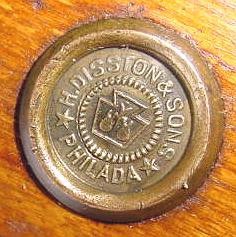
|
Probably 90% of Disston saws that collectors find will have one of the medallions shown from this point down to the bottom of the page. By 1900 Disston was making more saws than any other manufacturer worldwide, and their share of the market increased each year. Also by this time, Disston had bought over a dozen of its competitors, leaving only Atkins, Bishop and a newcomer to saw making, Simonds as major sawmakers in the US. Bishop stopped making saws in 1920, and Simonds made a strong impression on the market for only a short time, closing down in 1926. |
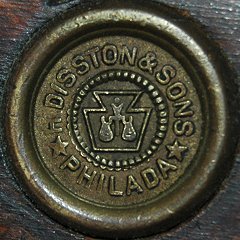
|
|
1917-1940 |
|||
|
(found on full-sized handsaws) |
(found on backsaws and panel saws as well as No. 16, D-20 and D-23 full-sized saws) |
||

|
At the same time this medallion appeared during World War I, Disston increased advertising in popular magazines and introduced new logos with the company name, saying simply DISSTON in capital letters arched over the keystone. The modified logo in advertising and shorter name on the medallions was probably done to improve brand identity. This medallion is found on Disston saws made both before and after the major product line change of 1928.
Because of changes in the saws' etches, the manufacturing date of saws with this medallion can be identified as being either before or after 1928. All handsaws were made after 1928 have a letter "D" in the name, for example: D-7, D-8, D-12. The letter is to the left of the number with a hyphen between them.
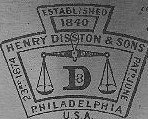
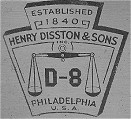 Some saws had a letter "D" in the name prior to 1928; the most common being the D-8. In all cases, those models with a "D" have etches in which the number appears inside of the letter. No handsaws with names like No. 7, No. 12, or No. 16 were made after 1928. |
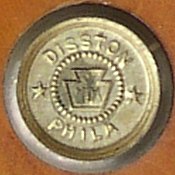
|
|
1940-1947 |
|||
|
(found on full-sized handsaws) |
(found on backsaws and panel saws as well as D-23 full-sized saws) |
||

|
This medallion appeared no later than 1940 because it appears on the 1940 Special handsaw that marked the 100th anniversary of the company. It reflects the international status of Disston products by this time, calling attention to the country of manufacture, not merely the city.

profile of medallion |

|
|
1947-53 |
|||
|
(found on full-sized handsaws) |
(found on backsaws and panel saws as well as D-23 full-sized saws) |
||
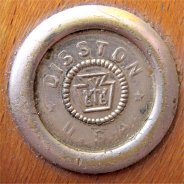
|
Saws from the late 1940's and early 1950's had this medallion with sloppy execution. Its perimeter is wide. D-8's and D-12's were nickel-plated; D-7's were the same style, but not plated.

profile of large medallion profile of small medallion |
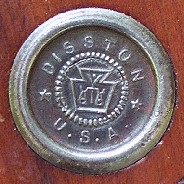
|
|
1953-55 |
|||
|
All medallions were this size |
|||
| The last Disston saws made under family ownership of the company were made in period 1953-55. The medallions were all 13/16" in diameter. When Disston was sold to HK Porter, most existing saw models were dropped from production and new home-handyman models were introduced along with a line of power saws. And that was, as they say, all she wrote.
|

|
||
1955-1990 Medallions
|
Warranted Superior Medallions
|
